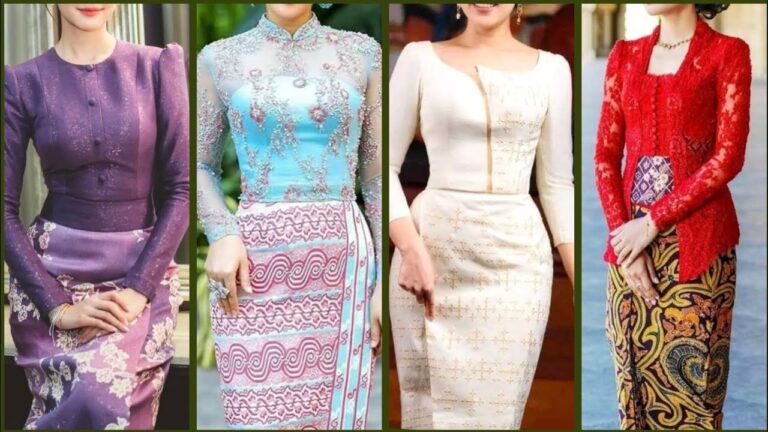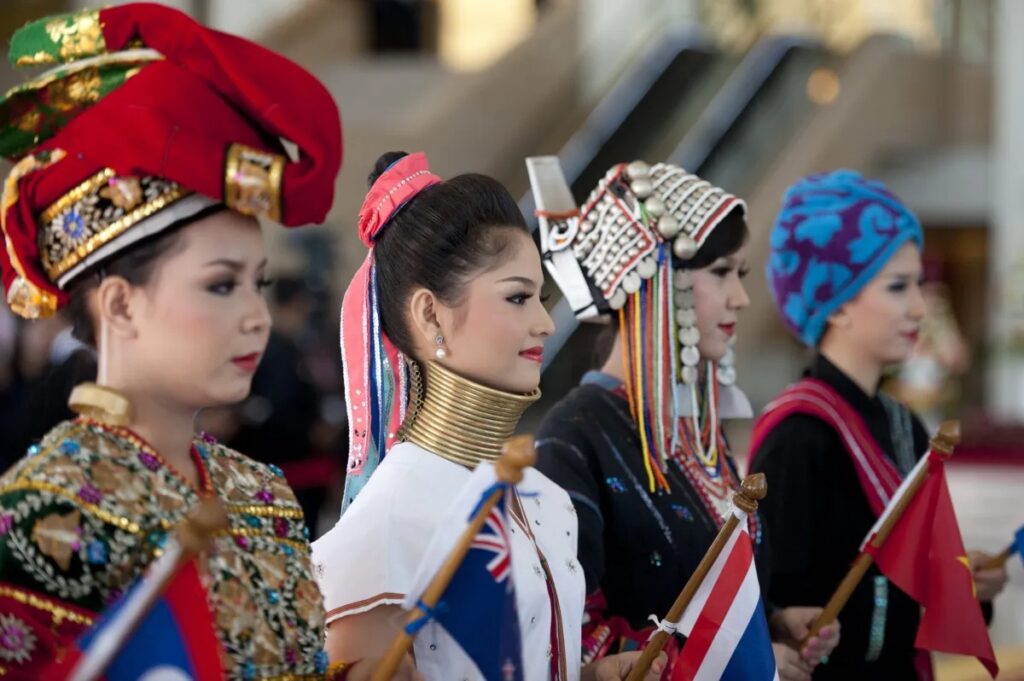Myanmar Traditional Costumes: Longyi, Htamein, and Ethnic Heritage
Introduction
Myanmar, formerly known as Burma, is a nation celebrated for its cultural richness and diversity. With over 135 ethnic groups, each community contributes unique traditions, languages, and dress. Among these, traditional costumes are one of the most vivid expressions of Myanmar’s identity.
These outfits are not merely garments. They are symbols of respect, social values, heritage, and pride. The most common attire is the longyi — a versatile cylindrical cloth worn daily by men and women. Beyond the longyi, Myanmar’s many ethnic groups showcase distinctive costumes that tell stories of history, artistry, and identity.
This article explores Myanmar’s traditional costumes, including the longyi, paso, htamein, ethnic attire, and their significance in today’s society.

The Longyi: Myanmar’s National Dress
The longyi is the cornerstone of Myanmar traditional clothing. This long cylindrical cloth, about two meters wide, is wrapped around the waist and tucked in. Both men and women wear it, but styles differ.
Men’s Longyi (Paso):
The paso is tied in a knot at the front. It comes in cotton for daily wear or silk for formal occasions. Men often pair it with a traditional jacket, especially during ceremonies or official functions.Women’s Longyi (Htamein):
The htamein is more colorful, with floral and geometric patterns. Women usually tuck it at the side, making it elegant and feminine. It is often combined with a fitted blouse, lace shawl, and traditional jewelry.
The longyi is popular because it is comfortable in Myanmar’s tropical climate. Lightweight, breathable, and stylish, it remains the attire of choice for millions.
Men’s Traditional Costumes
While the paso is essential, men’s costumes include other key elements:
Taikpon (shirt): A button-up shirt, often white or light-colored, sometimes with a Mandarin-style collar.
Jacket: For formal occasions, men wear a jacket over the shirt, similar to a suit but designed with traditional touches.
Gaung Baung (headscarf): A traditional turban-like headpiece, historically linked to nobility. Today, it is worn during weddings, ceremonies, or national events.
Footwear: Men often wear simple leather or velvet sandals, completing the modest yet elegant outfit.

Women’s Traditional Costumes
Myanmar women’s costumes are known for their elegance and vibrant artistry.
Htamein (longyi for women): Usually more colorful and patterned than men’s paso.
Blouse (Yinzi or Yin-ohn): A fitted top that may feature embroidery, sequins, or lace.
Shawl (Yinzi shawl): Worn across the shoulders during formal events.
Accessories: Fresh jasmine flowers in the hair, gold or silver jewelry, and thanaka (a natural cosmetic made from tree bark) on the cheeks add to the beauty.
Together, these elements create an image of grace and cultural pride.

Ethnic Diversity in Traditional Dress
Myanmar’s diversity is most visible in its ethnic costumes. Each ethnic group contributes unique artistry and meaning to the country’s wardrobe:
Shan: Known for bright longyis with checkered or striped patterns. Women’s outfits often include silver jewelry.
Chin: Famous for handwoven textiles in bold stripes and unique color contrasts. Traditionally, Chin women also wore facial tattoos, a practice now disappearing.
Kachin: Their ceremonial dress includes embroidered jackets and colorful headdresses adorned with beads and feathers.
Karen: Women wear handwoven tunics. Unmarried girls wear white tunics, while married women wear colorful versions decorated with beads.
Mon: Distinctive horizontal stripes in their htameins; Mon men wear checked paso.
Rakhine: Traditional dress is similar to Bamar style but often features local weaving techniques.
Chin: The Chin people are well known for their handwoven textiles that often feature bold stripes, bright colors, and intricate geometric patterns. Traditional Chin attire is crafted on backstrap looms, with each design representing a village or clan identity.
These costumes are displayed proudly during festivals, New Year celebrations, and traditional weddings.
Symbolism of Myanmar Traditional Costumes
Myanmar’s traditional clothing reflects deep cultural symbolism:
Modesty and Respect: Outfits are designed to cover the body modestly, reflecting cultural values of respect.
Unity in Diversity: Despite ethnic differences, the longyi unites Myanmar’s people under one shared garment.
Pride and Identity: Wearing traditional costumes symbolizes love for heritage and respect for ancestors.
Traditional Costumes in Daily Life
Even in the modern era, Myanmar people continue to wear traditional dress. Government officials, teachers, and students often wear longyis as uniforms. Weddings, pagoda festivals, and ceremonies see a showcase of colorful costumes.
Fashion designers are now modernizing the longyi, blending it with contemporary cuts and fabrics. This makes the attire appealing to younger generations while keeping traditions alive.
Traditional Costumes in Festivals and Ceremonies
Thingyan (Water Festival): Both men and women wear new longyis and traditional blouses to celebrate the New Year.
Weddings: The bride and groom dress in elaborate versions of paso and htamein, often made of silk and embroidered with gold or silver.
Religious Ceremonies: Devotees wear white or simple longyis when visiting pagodas, as a sign of purity and respect.
Ethnic Festivals: Each group wears its unique attire, showcasing Myanmar’s cultural mosaic.
Modern Adaptations
The longyi has not disappeared in the face of globalization. Instead, it is evolving:
Office Wear: Men wear tailored shirts with paso; women wear blouses with htamein in professional settings.
Fashion Industry: Designers combine longyi patterns with modern dresses, suits, and accessories.
Diaspora Communities: Myanmar people abroad proudly wear longyis and htamein at cultural events, maintaining their identity overseas.
Conclusion
Myanmar’s traditional costumes, from the everyday longyi to the vibrant ethnic outfits, remain a living heritage. They represent modesty, respect, unity, and cultural pride. Despite globalization, the longyi continues to thrive — proof that tradition and modernity can blend beautifully.
By preserving and wearing these costumes, the people of Myanmar not only honor their ancestors but also share their culture with the world.
FAQ About Myanmar Traditional Costumes
What is the national dress of Myanmar?
The longyi is Myanmar’s national dress, worn by both men and women.
What do women wear in Myanmar?
Women wear the htamein, a longyi variation, with a blouse, shawl, and accessories.
Do people still wear traditional costumes in Myanmar?
Yes. Traditional attire is worn daily and during ceremonies, weddings, and festivals.
What are ethnic costumes in Myanmar?
Ethnic groups such as Shan, Chin, Karen, and Kachin have their own distinctive outfits with unique patterns, weaving, and symbolism.
